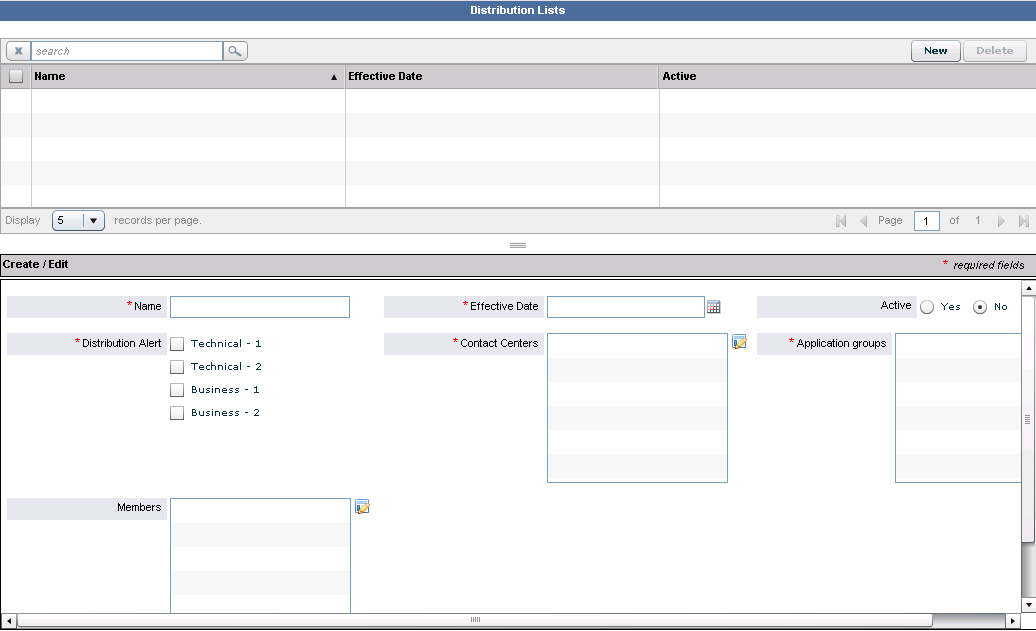Distribution Lists
CCAdv and WA can send e-mail notifications to specified distribution lists. The notifications are about:
- Alerts caused by metrics' violations of thresholds. See Application Groups and Thresholds for detailed information about how CCAdv and WA use these lists to notify users about alerts.
- Alerts about offline peripherals.
- An external source system has not provided updated real-time data within a configurable interval. See System Configuration.
The following screenshot shows the Distribution Lists page.
Threshold Violations Alerts and Offline Peripheral Alerts
Assign contact centers and application groups to distribution lists in order for users to receive email notifications about threshold violation alerts or peripheral offline alerts. The users will receive email about alerts that are created for applications or contact groups related to the application groups or contact centers.
A distribution list must always have at least one contact center and one application group associated with it. When assigning a network contact center, you can also add its related agent group contact centers.
In the Distribution Lists page, you will not see contact centers and application groups to which you have no permissions assigned in the Genesys Configuration Layer.
Distribution lists are associated with a specific type of alert. The types are:
- B1 and B2 for business alerts. (1 means critical severity, and 2 means warning severity)
- T1 and T2 for technical alerts
The distribution list sends email only about alerts whose type and severity match the types and severities for which the list is configured.
Email and Permissions in Configuration Layer
Email regarding alerts about threshold violations or offline peripherals is sent only to users who have permissions configured in the Genesys Configuration Layer to the contact center, application group, and geographic region related to the alert. Access to these objects must be configured by an administrator in Genesys Configuration Manager. See CCAdv/WA Access Privileges.
Advisors modules receive information about a user's permissions to the contact center, application group, and geographic region objects at different times, depending on the module. WA gets information about a user's permissions when the user logs in to Advisors. CCAdv gets information about users' permissions when XML Generator starts; XML Generator checks for updates to permissions settings in the Configuration Layer every 24 hours after that. The 24-hour refresh cycle means that changes to users' permissions do not take effect immediately with regard to email about alerts, with the following results:
- CCAdv can continue to send email about an alert to a user for up to 24 hours after you removed that user's access permission to the related object.
- CCAdv does not send email about an alert to a user to whom you have recently granted access permission to the related object, for up to 24 hours after you granted access.
Alert Email Notification about Source System Not Updating Data
Contact Center Advisor sends e-mail to a distribution list if an external source system has not provided updated real-time data within a configurable interval. See System Configuration. When sending this e-mail, Contact Center Advisor ignores the Distribution Alert settings of the distribution list, even though at least one checkbox must be selected. Contact Center Advisor also ignores the application groups and contact centers assigned to such a list when sending e-mail about these failures.
Selecting Individual Distribution List Members
If you select individual distribution list members, you must assign manually any members added in the future.
Working with Distribution Lists
Procedure: Maintain Distribution Lists
Steps
- On the navigation bar, select Distribution Lists.
- To add a new distribution list, do one of the following:
- Click New and begin adding details in the Create/Edit panel.
- Click in the Name field and begin adding details in the Create/Edit panel.
- To edit a distribution list, do one of the following:
- Select its check box in the upper panel and edit the details in the Create/Edit panel.
- Search for it using the Search feature above the upper panel, then select its check box and edit the details in the Create/Edit panel.
- Click the Save button.
A confirmation message displays.
Procedure: Delete a Distribution List
Purpose: Delete a distribution list to stop subsequent alert notifications. Note that you can deactivate a distribution list instead of deleting it to avoid the need to re-enter it in the future.
Steps
- On the navigation bar, select Distribution Lists.
- To display the details of a user, either select the check box for a user from the list in the upper panel, or search for a specific user and then select the checkbox associated with that user.
- Click the Delete button.
A confirmation window displays. - To confirm the deletion, click OK.
A message confirms the deletion.

